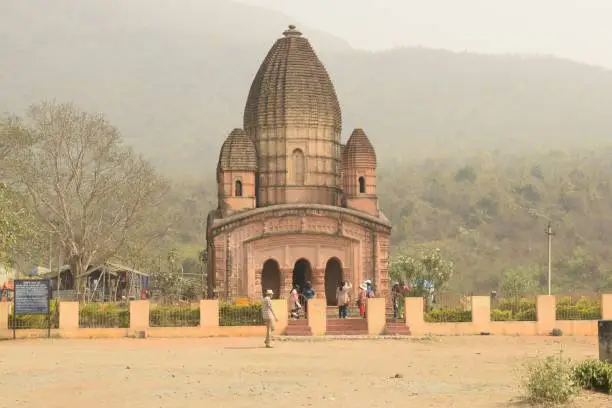Perched below the tranquil Panchet Hill in Purulia, West Bengal, Garpanchkot (or Garh Panchkot) is where myth, history, and nature weave into one timeless tapestry. Once a royal fortress echoing with the grandeur of Bengal’s ancient dynasties, today it stands as a quiet refuge for travelers seeking a blend of heritage and Himalayan tranquility.
Origins Lost in Time
The roots of Garpanchkot trace back nearly two millennia. Historical and folkloric accounts suggest it was founded around 80–90 CE by King Damodar Sekhar, the first ruler of the Singh Deo Dynasty, who allegedly descended from Raja Jagat Deo of Dhar (in today’s Madhya Pradesh).
Over the centuries, this dynasty fortified its capital at the foothills of Panchet Hill, establishing Garh Panchkot, meaning “Fort of the Five Clans.” The kingdom remained powerful until the mid-18th century, ruling continuously for over 800 years.
The Fall: The Bargi Devastation
The turning point came during the Bargi attacks, a decade of Maratha incursions into Bengal between 1741 and 1751. The fortress—once surrounded by moats and stone walls—was overrun by ragtag cavalry forces under Raghoji Bhonsle of Nagpur, drawn into Bengal by the political rivalry between Nawab Alivardi Khan and Rustam Jung.
Historical estimates from Dutch sources suggest that as many as 400,000 civilians perished during these raids across Bengal. Folk culture still bears the scars of that time; traditional lullabies like “Khoka ghumalo, paada judaalo, Bargi elo deshe” recount these horrors.
Folklore tells of the 17 queens of the Panchkot kingdom who committed mass suicide in a nearby well to avoid capture—an event that still shapes the spiritual aura of the ruins. These myths lend Garpanchkot a haunting majesty, its broken fort walls seemingly murmuring laments from history.
Architectural Grandeur and Design
The remains of Garh Panchkot Fort include fragments of defense walls, battlement bases, and a semi-circular moat, once filled with water for protection. The only access was via boats—testimony to the kingdom’s strategic ingenuity.
Nearby lie scattered terracotta temples, blending the Bishnupur Jorbangla style with older stone-built Shakti shrines. The Pancharatna Temple, extensively renovated, showcases intricate carvings of lotus medallions and mythic scenes from epics.
The Panchkot Hill itself rises to 610 meters (2,000 feet) and offers panoramic views of the Damodar Valley project area, including Panchet Dam and Maithon Reservoir. Its forest cover—predominantly sal, teak, and mohua—attracts bird species such as Indian rollers, drongos, and parakeets.
Garpanchkot Through the Ages
| Period | Key Event | Approx. Year | Significance |
|---|---|---|---|
| Early Kingdom | Establishment by King Damodar Sekhar | 80–90 CE | Foundation of the Singh Deo Dynasty |
| Pala–Sena Era | Temple architecture flourishes | 700–1200 CE | Religious and artistic expansion |
| Bishnupur Link | Temporary annexation by King Bir Hambir | c. 1600 CE | Cultural exchange with the Malla kingdom |
| Maratha Invasion | Bargi raids devastate Bengal | 1741–1751 | Fall of the fort, 17 queens’ tragedy |
| Colonial Period | Survey by Joseph David Beglar (ASI) | 1862 | Archaeological acknowledgment |
| Modern Revival | Eco-tourism was introduced by the WB Government | 2015–present | Community-based sustainable tourism |
Travel Experience in 2025
Recent reports indicate that more than 45,000 visitors explored Garpanchkot in 2024 alone—a 30% rise over pre-pandemic figures. The site benefits from West Bengal’s regional eco-tourism initiative, promoting heritage preservation alongside local employment.
Adventure Activities:
-
Rock climbing and rappelling near Panchet Hill
-
Boating at Panchet Dam and Muradi Lake
-
Nature trails offering glimpses of Purulia’s red laterite soil ecology
Cultural Touchpoints:
-
Folk performances featuring Chhau dance and Baul music
-
Exhibitions of handmade Dokra art and tribal patachitra
Environmental Insight: Garpanchkot lies within the Chota Nagpur Plateau ecosystem, housing over 120 bird species, 30 floral varieties, and several medicinal plants locally used by tribal healers.
Where to Stay: Comfort Meets Consciousness
Eco-resorts around Garpanchkot, like Palashbithi Eco Resort and Aranye Dinratri Tourism Project, lead community-driven hospitality. Many are powered by solar grids and follow zero-waste kitchen practices.
Average rates (2025):
-
Standard cottage: ₹4,499–₹5,200 per night
-
Family cabins (4 beds): ₹7,800–₹9,000
-
Luxury tents: ₹5,800 (including meals and campfire)
Amenities include Wi-Fi, scenic lawns, and locally sourced Bengali and Chinese cuisines. Some even organize moonlit astronomy nights, offering telescopic views of star trails against Panchet Hill.
How to Get There
-
By Road: 250 km from Kolkata (NH19), 5–6 hours by car.
-
By Train: Muradi Railway Station (6 km away) on the Asansol-Adra line.
-
By Air: Kazi Nazrul Islam Airport (Durgapur), 75 km from the site.
Trip operators offer customized weekend tours combining Baranti, Biharinath, and Joychandi Hills, often with heritage photography sessions and drone mapping add-ons.
Best Time to Visit
| Season | Avg. Temperature | Highlights |
|---|---|---|
| Winter (Nov–Feb) | 8–24°C | Cool weather, best for hiking & temple visits |
| Monsoon (Jul–Sep) | 20–30°C | Lush greenery, waterfalls, and photography |
| Summer (Apr–Jun) | 35–45°C | Avoid if you prefer milder temperatures |
Quick Facts & Curiosities
-
Etymology: Garh Panchkot means “fort of five clans”—a nod to its foundation by multiple tribal chieftains.
-
Literary Link: Poet Michael Madhusudan Dutt lived here in the 1870s and composed three poems inspired by the ruins.
-
UNESCO Status: Under review by the West Bengal Heritage Commission, Garh Panchkot is on a preliminary list for regional heritage protection.
-
Local Economy: Around 65% of households near Neturia Block now depend directly or indirectly on tourism.
The Living Legacy
To walk through Garh Panchkot is to trace the veins of Bengal’s forgotten soul—the blend of earth, fort, and faith. Between decayed watchtowers and temple shadows, wild orchids bloom where royalty once stood guard.
For those drawn to destinations that echo with memory, Garpanchkot offers not just a journey outward—but inward, into Bengal’s deep ecological and cultural consciousness.
Read also: The adventure trip: best in India

